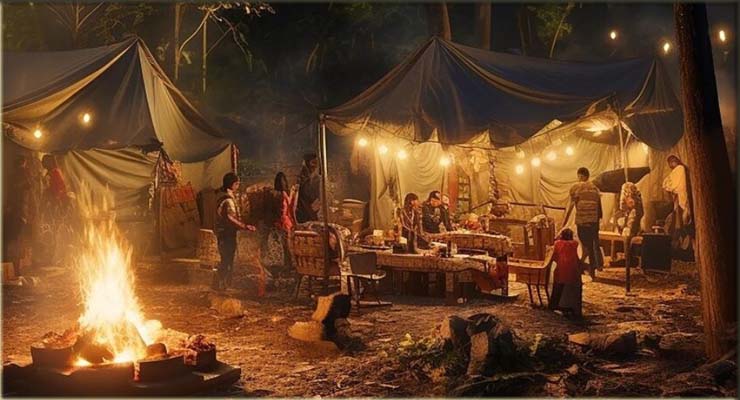Mamgatoto has a profound meaning, as it encompasses various cultural, historic, and contemporary contexts. Mamgatoto’s ancient roots, embedded in the folklore and traditions of diverse global communities have evolved to touch various aspects of human existence. Mamgatoto, whether as a mythical character passed down from generation to generation or as an enchanting theme in manga and contemporary entertainment, continues to inspire and intrigue.
Mamgatoto is best understood by exploring its rich tapestry of cultures, which spans continents and centuries. This article will unravel the mysteries surrounding Mamgatoto by providing readers with a guide to its cultural significance, historical background, and contemporary interpretations. We will examine the fascinating stories and legends surrounding Mamgatoto. We will also explore its role in rituals, traditions and its influence on the culinary world. You will have a greater understanding of Mamgatoto, its impact on culture and the society.
THE HISTORICAL BACKGROUND OF MAMAGATOTO
Origins and History of Mamgatoto
Mamgatoto has its origins in ancient times and is deeply rooted within the folklore and traditions of many communities around the world. This term, which is believed to have originated from an ancient tongue, represents harmony and innovation. Mamgatoto was historically a cultural practice unique in that it combined storytelling, spirituality and community bonds.
Traditions and folklore
Mamgatoto is an important part of many societies’ cultural heritage. Its importance in folklore can’t be overstated, since it embodies people’s fears, moral values and aspirations. Mamgatoto’s stories are handed down from generation to generation, preserving their relevance and significance. These stories often portray Mamgatoto in a mythical or spiritual form, which highlights the connection between natural and supernatural realms.
Communities and Cultures
Mamgatoto’s significance varies from one community to another, but its essence is the same. In some African cultures Mamgatoto, for example, is revered as the protector of the community. In Asian folklore Mamgatoto may appear wise and benevolent as he guides individuals through the challenges of life. The universality of Mamgatoto’s themes–protection, wisdom, and guidance–underscores its enduring appeal across diverse cultures.
Examples of Global Traditions
Mamgatoto has influenced many global traditions. Mamgatoto is performed in African tribal communities to ensure a successful harvest or to ward off evil spirits. These rituals include elaborate dances and chants that highlight the spiritual and communal aspects of Mamgatoto. Mamgatoto is also celebrated in Asian festivals through parades and theatrical performances.
Mamgatoto in Folklore and Legends
Global Folklore and Mamgatoto
Mamgatoto has a rich history in global folklore. It is often portrayed as a mythical creature or concept, which transcends the ordinary. These stories are woven into local traditions and reflect the collective imagination of the communities who cherish them.
Legendary Creatures and Concepts
Mamgatoto is often portrayed as a mythical being endowed with superhuman powers. These creatures can take on a variety of forms and abilities depending on their cultural context. Mamgatoto is often portrayed in African folklore as a powerful guardian, taking on the form of an animal revered by Africans, such as a lion, eagle, or lion. These manifestations represent strength, wisdom and protection in the community.
Mamgatoto is often depicted in Asian folklore as a wise man or a mystical figure who guides heroes through their quests. This version of Mamgatoto helps characters overcome trials and tribulations by providing knowledge and illumination.
Myths and Stories
Mamgatoto is a lion-like spirit that saves a village of drought in African folklore. According to legend, the villager’s suffering from an extended dry season seeks help from Mamgatoto. The villagers summon the spirit with rituals and gifts, which bring rain and prosperity to their land. This story emphasizes themes of community effort and Mamgatoto’s benevolence.
Mamgatoto is a popular legend in Asian tradition. It depicts him as an old sage that imparts wisdom to young princes. In a dense wood, the prince who is lost and searching for purpose meets Mamgatoto. Mamgatoto guides the prince to his true calling through riddles, philosophical teachings and a wise leadership of his people. This story shows the guidance and enlightenment Mamgatoto offers.
Cultural Symbolism
Mamgatoto’s legends often have deep symbolic meanings. The stories reflect the moral and ethical values of society, teaching lessons on bravery, wisdom and community. Mamgatoto is also present in these stories to emphasize the belief in supernatural forces and unseen influences that affect daily life.
MAMGATOTO – MODERN ENTERTAINMENT
Mamgatoto in Manga
Mamgatoto is a modern form of entertainment that has gained a large audience, especially manga and anime. The term is associated with a sub-genre or style of manga that has captivated readers with its complex plots and captivating characters. One notable example is “The Reason Why Ophelia can’t get away from The Duke,” a thriller manga series that, while not related to Mamgatoto shares themes of mystery and drama with Mamgatoto.
A thrilling plotline and compelling characters
Modern manga and animation featuring Mamgatoto are often centered around intricate and thrilling plotlines. These stories are marked by surprising twists, character development and psychological elements which keep the reader engaged. These stories are characterized by moral dilemmas, encounters with supernatural beings and complex relationships.
In “The Reason Why Ophelia can’t Get Away from The Duke”, the protagonist Ophelia is caught in an emotionally charged and suspenseful storyline that involves her stepbrother Alexander. The tension between characters and the changing dynamics of their relationships draw readers into an intriguing world that reflects Mamgatoto’s mysterious and multifaceted nature.
Impact on Popular Culture
Manga and anime based on the mamgatoto have had a significant impact on popular culture both in Japan and around the world. These works explore themes such as identity, morality and the supernatural. They resonate with a broad audience. The storytelling is further enhanced by the artistic style, which features detailed illustrations and expressive character design.
Mamgatoto is a global phenomenon, as evidenced by the growth of the fanbase, the popularity of merchandise and fan art and the online communities. Fans interact with these stories across multiple platforms, creating an exciting culture around Mamgatoto.
Beyond Manga – Mamgatoto on Other Media
Mamgatoto has a wider influence than manga and anime. Films, video games, literature, and even video games use elements of Mamgatoto’s storytelling and depth. Mamgatoto is often used to inspire the creation of immersive, rich worlds, and complex characters in these media.
Cultural Significance
Mamgatoto’s portrayal in modern entertainment shows its adaptability and relevance. Creators bridge the past and present by incorporating traditional themes in contemporary narratives. They offer new interpretations of Mamgatoto which resonate with today’s audiences. This fusion between old and new ensures that Mamgatoto’s spirit is kept alive and its influence on culture and story-telling continues.
CULTURAL SIGNIFICANCE
Mamgatoto: Cultural Importance
Mamgatoto is a cultural icon that has a profound impact on many communities around the world. It’s more than a myth, it represents the values, beliefs and traditions of those who venerate it. Mamgatoto is the essence of a communal identity. It connects past and present, and allows individuals to reconnect with their heritage.
Symbol of Protection and Wisdom
Mamgatoto, in many cultures is revered as an esoteric spirit or symbol of wisdom. This depiction highlights its role as a protector of the community, and teaches important lessons. Mamgatoto, as a protector is said to keep away evil spirits and ensure the safety and prosperity for the people. Mamgatoto is a symbol for wisdom and helps people overcome challenges.
Rituals & Practices
Mamgatoto rituals are varied, and reflect the cultural contexts where they are performed. These rituals can be elaborate and spiritual. They often include dance, music and other elements.
African Rituals
Mamgatoto is a ritual that’s performed in African tradition to gain blessings, protection and guidance. These ceremonies are characterized by intricate dances, rhythmic chanting and drumming. They create a powerful experience for the community. To honor Mamgatoto, food, drinks, and symbolic items are offered.
Asian Traditions
Mamgatoto is often celebrated in Asian cultures during festivals and special ceremonies. In these events, stories about Mamgatoto may be acted out through dance and drama. Participants can also engage in meditation practices to connect with Mamgatoto’s wisdom and spiritual guidance.
Meanings of Rituals
Mamgatoto rituals are full of symbolism. The offerings that are made during these ceremonies can represent gratitude, respect and harmony with the spirit world. Dances and music are not just forms of expression, but also a way to invoke the blessings of Mamgatoto.
MAMGATOTO AS CULINARY EXPERIENCE
Mamgatoto: An Introduction to the Cuisine
Mamgatoto’s influence extends far beyond entertainment and folklore, extending into the culinary traditions from various cultures. Mamgatoto is a culinary experience that transcends food. It showcases a rich tapestry, culture, diversity and unique flavors. Mamgatoto’s culinary experience highlights the role of food as a means of cultural expression and community connection.
Culinary Traditions Using Mamgatoto
Mamgatoto is a cuisine rooted in traditions and history of the communities who celebrate it. These dishes are prepared by using old recipes that have been passed down from generation to generation, with each having a unique twist.
African Culinary Practices
Many African cultures cook Mamgatoto inspired dishes for special occasions and festivals. These meals are often a mixture of local ingredients, traditional spices and cooking techniques that have been preserved for centuries. The dishes might include stews and roasted meats as well as a variety of colorful vegetable sides. These meals are shared communally, which fosters a feeling of celebration and unity.
Asian Culinary Traditions
Asian interpretations of Mamgatoto food may focus on the harmony of flavors and presentation. The meals are prepared with great care to ensure that they not only taste good but also look appealing. Rice, fish and various vegetables are used as ingredients that represent different cultural symbols. The cooking and sharing of these meals are seen as a means to honor Mamgatoto, and the values that it represents.
Unique Flavors & Ingredients
Mamgatoto food is characterized by its distinctive flavors and ingredients, which reflect the cultural heritage of the community. Spices and herbs play a major role, and are often chosen for their taste and symbolic meaning. The dishes are characterized by a variety of ingredients, including millet and yam. Fish and greens also play a major role in the flavor.
Festivals and Celebrations
During festivals and celebrations, Mamgatoto’s culinary tradition is often highlighted. These events are marked by elaborate feasts that feature a wide variety of Mamgatoto-inspired dishes. The cooking and sharing of these meals is a great way to bring people together, celebrate heritage and pass on culinary knowledge to the younger generations.
MODERN ADAPTATIONS AND SYMBOLISM
Mamgatoto Symbolic Meanings
Mamgatoto has many symbolic meanings that represent various aspects of nature, life, and the supernatural. Mamgatoto’s symbolism is often based on themes of protection, harmony, wisdom and innovation. These themes are reflected in stories, rituals and cultural practices. Mamgatoto, for example, is a spirit that protects against misfortune and evil. It is a wise being that represents wisdom and guidance.
Modern Interpretations
Mamgatoto’s core symbolism has been retained in contemporary settings while adapting it to modern narratives. You can see these adaptations in different forms of media, including cultural expressions.
Mamgatoto Literature and Film
Mamgatoto is often reinterpreted in modern literature and film, which combines traditional elements with current themes. These adaptations can portray Mamgatoto in stories that examine contemporary issues like identity, community and resilience. In doing so, the adaptations keep Mamgatoto’s essence alive and make it relevant for today’s audiences.
Artistic Representations
Mamgatoto is a source of inspiration for artists and designers, who create works that are infused with its symbolism. Visual arts, fashion and architecture all feature artistic representations of Mamgatoto. These works show how Mamgatoto themes such as harmony and innovation are incorporated into modern creative endeavors.
Festivals of Culture and Performances
Mamgatoto is celebrated through cultural festivals that combine traditional rituals and contemporary performances. These festivals include contemporary music, dance and theatre productions, which reinterpret Mamgatoto stories for a younger generation. These events preserve Mamgatoto’s cultural significance while making it engaging and accessible to contemporary audiences.
CONCLUSION
Mamgatoto, a cultural phenomenon that transcends time and space, is an expression of ancient tradition, modern entertainment, culinary art, and symbolism. The deep-rooted importance of Mamgatoto in folklore and rituals as well as its contemporary adaptations demonstrate its versatility and lasting appeal. We discover a rich tapestry in Mamgatoto as we examine its multifaceted nature. Understanding and appreciating Mamgatoto connects us with a richer cultural heritage which enriches and inspires the future. This exploration of Mamgatoto emphasizes the timeless connection between innovation and tradition, emphasizing their role in shaping and reshaping cultural narratives.
FAQ SECTION
1. What is Mamgatoto
Answer: Mamgatoto, a multifaceted phenomenon deeply rooted within the folklore and traditions of many communities around the world. It can be a mythical being, an artistic form, or a symbol, embodying themes such as protection, wisdom and harmony. Mamgatoto is a modern form of entertainment that has influenced culinary traditions, artistic expressions, and modern entertainment.
2. What is the origin of Mamgatoto?
Answer Mamgatoto, a term that is thought to have originated from an ancient tongue, represents a mix of harmony and innovation. It was historically a unique culture that incorporated elements of spirituality, storytelling, and community bonds. The etymology of the word varies between cultures, which reflects its wide influence and adaptation.
3. What is Mamgatoto’s folklore representation?
Mamgatoto appears in global folklore as a supernatural or legendary creature. In African folklore it may appear as a spirit guardian in the form of revered creatures like lions and eagles. In Asian tradition, Mamgatoto is often portrayed as an eloquent sage who guides heroes in their quests. These portrayals emphasize themes of wisdom, protection, and moral guidance.
4. What is the role of Mamgatoto in modern entertainment?
In the modern world of entertainment, Mamgatoto is a theme that has been popularized in manga and anime. It’s characterized by complex plots and captivating characters. Mamgatoto is a theme that can be found in many manga and anime, such as the thriller “The Reason why Ophelia cannot get away from the Duke”. Mamgatoto entertainment explores themes such as identity, morality and the supernatural. It resonates with audiences around the world.
5. What is Mamgatoto’s cultural significance?
Answer Mamgatoto is a deep symbol of cultural identity, protection and wisdom. The communities that venerate it celebrate Mamgatoto through rituals and practices which reflect their values and beliefs. These rituals are often accompanied by dance, music and offerings that emphasize the spiritual and community aspects of Mamgatoto.
6. What is the role of Mamgatoto in culinary traditions?
Answer: Mamgatoto influenced culinary traditions. Dishes prepared using ancient recipes reflect the cultural heritages of different communities. Mamgatoto meals in African cultures are shared communal events that include stews, roasted vegetables, and meats. In Asian cultures, meals emphasize harmony and balance using rice, vegetables, and fish to create visually pleasing and symbolic meals.
7. What are some of the most notable Mamgatoto stories?
_________________________________________________________________________________________________________________________________________________________________________________________________________________ These stories reflect the morals and ethics of the communities who tell them, and highlight Mamgatoto as a protector.
8. What is Mamgatoto’s representation in contemporary art?
Modern artistic expressions are inspired by Mamgatoto and incorporate its symbolism into visual arts, architecture, and fashion. Artists create artworks that are relevant to modern audiences by reflecting Mamgatoto themes of innovation and harmony. These works keep Mamgatoto’s cultural significance alive through new and engaging representations.
9. What is the symbolism of Mamgatoto?
Mamgatoto represents protection, wisdom and harmony. It is a protector spirit that brings safety and prosperity to the community. It is a wise entity that offers guidance and illumination. Mamgatoto’s stories, rituals and cultural practices reflect these symbolic meanings.
10. What is the influence of Mamgatoto on contemporary culture?
Mamgatoto continues its influence on contemporary culture by integrating it into modern entertainment, culinary tradition, and artistic expressions. The themes of Mamgatoto are reinterpreted through literature, films and festivals that blend traditional elements with modern narratives. Mamgatoto’s ongoing adaptation is a way to ensure that it remains an important part of the cultural heritage and bridges the gap between past and present.


